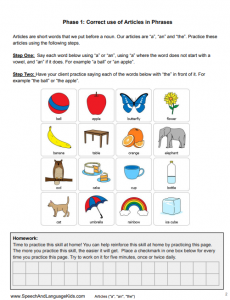How to Teach Articles:
Speech Therapy for “a”, “the”, “some”
Children with language delays often leave out articles like “a”, “the”, and “some”. This can make their speech choppy and hard to follow. Your child should be using articles by 4 years of age. Some children start using them much earlier but this is a good point of reference for when you may want to start intervention. Teaching articles can be easier than you think though, just try these three steps.
Teaching Articles Step One:
Articles in Short Phrases
We will start teaching articles by simply asking your child “what’s this” and having her reply with an article such as “a”, “the”, or “some”. Start with several pictures of common objects. You can use the pictures in the Speech and Language Therapy Guide or create your own. Show your child a picture of an object and say “what’s this?”
Your child will probably say the name of the object but not include any articles. Demonstrate for your child how to say the word with an article. Start with just pictures of single items at first so that you can practice “a” and “the” in front of the word. You can say “a dog” or “the chair”. You will probably need to say it for your child for a while and have her practice saying it back to you. Eventually, your child should get to the point where she can say it on her own with the article.
Once she can do this, move on to pictures of multiple objects. Then, help your child use the article “some” in front of those. Explain to your child that when there’s more than one of something we say “some”. Your child will need to have some concept of quantity in order to do this, at least enough to know when there is one or more items.
Help your child practice saying “some ____”. You can also help her add the plural /s/ or irregular plural word on there as well, as long as she doesn’t get too overwhelmed. Once she can use “some” consistently, start switching between pictures with one item and pictures with many.
This should give her practice at switching between “a” or “the” and “some”. Keep in mind that “the” can be used for single or multiple items.
Teaching Articles Step Two:
Teaching Articles in Sentences
Now that your child can use articles in short phrases, it’s time to move up to the big leagues, time for sentences! Get out the pictures you used in the last step and show your child a picture. Ask him to come up with a sentence about this word. You may have to help him come up with sentences at first if he’s not used to this type of task. Say the sentence for him and have him repeat it back to you. Make sure he uses the correct article in the sentence. Use the different articles in different sentences so he gets practice with a variety of them. Once he starts to get the hang of it, you can have him come up with the sentences on his own.
If your child is having trouble with this step, try using some simple repetitive sentences at first. You can say “I see a ___” or “Give me the ____” for each sentence for a while. Then, as he starts to get better at it, you can add in some different sentence types and eventually make it to the point where he’s making up his own sentences.
Teaching Articles Step Three:
Teaching Articles in Book-Reading Activities
Time to bump it up again, now you get to work on helping your child say the articles during book-reading activities. Sit down with your child for some book-reading time. Find a comfy spot to work and let your child choose the books. Practice the following activities while making sure your child is using appropriate articles:
- Ask your child to describe the pictures to you. Have her tell you what’s going on in each of the pictures while making sure to use her good articles. If she forgets one, gently remind her to include it.
- Ask your child questions about what’s going on in the story or pictures. You can ask questions like “what’s this?”, “what does she have?”, “what did she do?”, and “what is she going to do next”.
- Have your child recall what happened after you finish reading the story.
- Show your child the written word for one of the articles. Help your child find that word in the printed text of the book and then read that sentence back to her.
- Have your child “read” you the book by making up a story based on only the pictures.
If your child forgets an article during any of these activities, gently remind her to use it and have her imitate the sentence back to you correctly.
Teaching Articles Step Four:
Teaching Articles in Conversation
Now that your child can use articles in sentences and structured activities, we want him to start using them all the time. Start listening to your child’s use of articles during conversational speech. If he’s beginning to use them, then you will just need to remind him every once in a while along the way. However, if he’s not yet using them, he may need a little boost. Try some of these activities to improve his ability to use articles in conversation. The ideas at the top of the list will be easier and should be used before the later ones.
- Repeat back the sentences that he says with missing articles but add them back in. Exaggerate the article when you say it. For example, if he says “I see dog”, you can say “you see A dog”.
- Repeat back his sentences with missing articles exactly the way he said it but make it sound like you’re confused. You could say “you see dog?”. See if he can correct it to add the article on his own. If not say “Oh, you see A dog. Tell me that, say ‘I see A dog’.”
- Point out when you hear him miss articles. You can say “Oh, I hear an article there, listen: “I see A dog”. See if he can repeat it back to you.
- Remind him to use an article by saying something like “I think you forgot your article, can you say that again?”
When your child is using articles in conversation about 80% of the time, you can stop working on it directly. At that point, you will want to just monitor and make sure your child continues to use articles, but you can move on to working on a different speech and language skill.
Pre-Made Therapy Kit for Teaching Articles:

About the Author: Carrie Clark, MA CCC-SLP
Hi, I’m Carrie! I’m a speech-language pathologist from Columbia, Missouri, USA. I’ve worked with children and teenagers of all ages in schools, preschools, and even my own private practice. I love digging through the research on speech and language topics and breaking it down into step-by-step plans for my followers.
Connect with Me:







how can you use article ‘some’ with suitable example and rules for its
The information in this post is incredibly helpful. I think your article was the greatest I read today. Thanks